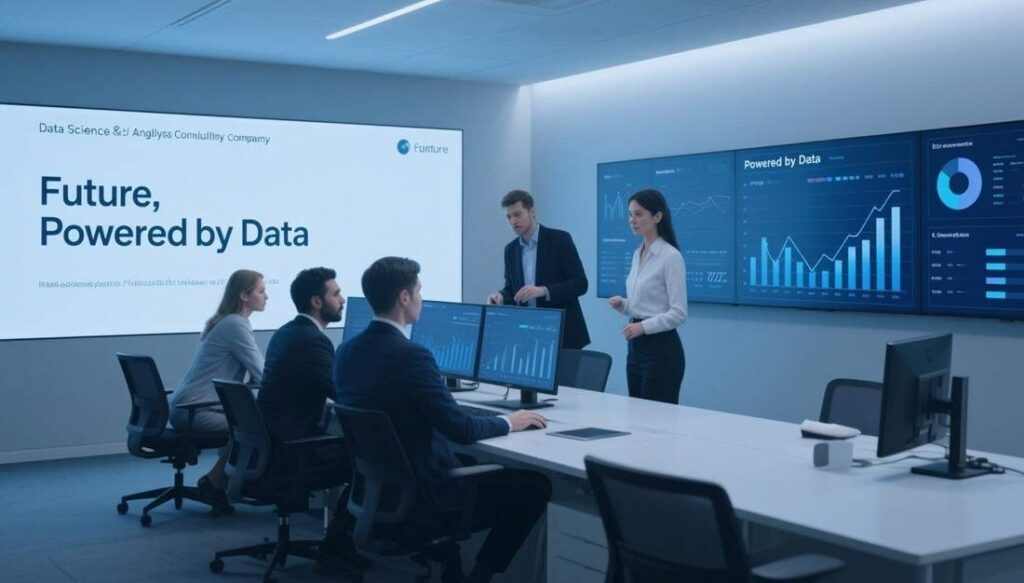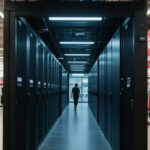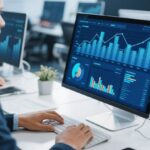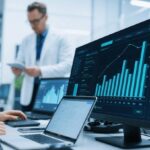
In an era where every click, transaction, and sensor reading generates valuable information, those who master data don’t just predict the future—they create it. Welcome to the age of intelligence, where algorithms unlock solutions to problems we once thought unsolvable.
From healthcare breakthroughs to smart cities, data-driven innovation is transforming every industry. Here’s what’s next.
Imagine doctors predicting disease outbreaks before they happen. Picture cities that optimize traffic flow in real-time, slashing commute times and emissions simultaneously. Envision retail experiences so personalized that products find you before you even realize you need them.
This isn’t science fiction—it’s the emerging reality of our data-driven world, where the convergence of massive information sets, advanced analytics, and artificial intelligence is fundamentally changing how we live, work, and solve problems.
The Data Revolution: Why Every Industry Is Going Digital
How AI and Big Data Are Redefining Business, Healthcare, and Governance
The numbers are staggering: humanity now generates an estimated 2.5 quintillion bytes of data every day. But raw information alone offers limited value—it’s the ability to process, analyze, and derive actionable insights from this data that has sparked a global transformation.
In healthcare, algorithms now analyze medical images with accuracy that rivals or exceeds human radiologists, while predictive models identify patients at risk for conditions before symptoms appear. One study from Stanford Medicine showed AI systems detecting pneumonia from chest X-rays with 95% accuracy, potentially saving critical diagnosis time.
Financial institutions have revolutionized risk assessment, using behavioral data and transaction patterns to make lending decisions in seconds rather than days. According to McKinsey, banks implementing advanced analytics have seen up to 30% increases in sales of new products and 25% reductions in churn rates.
Meanwhile, governments are leveraging data to enhance public services, from optimizing emergency response times to detecting potential infrastructure failures before they occur. In cities like Singapore and Barcelona, data from thousands of sensors guides decisions on everything from waste management to energy conservation.
“Data has fundamentally changed the relationship between businesses and customers,” explains Dr. Maya Reynolds, Director of Data Science at Global Insights Research. “Companies that make data-driven decisions are seeing tangible advantages—they’re 23% more profitable than competitors who don’t prioritize analytics.”
AI and Machine Learning: The Brains Behind the Data Boom
From Predictive Analytics to Self-Learning Algorithms – How Machines Are Getting Smarter
While big data provides the raw material, artificial intelligence and machine learning supply the processing power that transforms information into insight. These technologies don’t just analyze past patterns—they learn continuously, improving their accuracy and capabilities over time.
Predictive analytics represents the first wave of this revolution, using historical data to forecast future outcomes. But today’s most advanced systems go further, employing deep learning networks that can identify complex patterns invisible to traditional analysis.
Take manufacturing, where predictive maintenance algorithms now detect equipment failures before they happen by analyzing subtle changes in vibration, temperature, and other operational data. German automotive manufacturer BMW reports reducing production downtime by 25% through such systems, saving millions in lost productivity.
Natural language processing (NLP) has advanced to the point where AI can understand context and nuance in human communication. Virtual assistants and chatbots now handle millions of customer interactions daily, resolving issues that once required human intervention.
“The difference between AI systems today versus five years ago is remarkable,” notes Ryan Chen, Chief AI Officer at TechFuture Solutions. “Today’s algorithms don’t just follow rules—they discover new patterns and approaches that sometimes surprise even their creators.”
Perhaps most transformative is the emergence of generative AI, capable of creating new content—from photorealistic images to functional code—based on its training. These systems are revolutionizing creative fields and accelerating innovation across industries.
Smart Cities and IoT: Building the Future with Real-Time Insights
How Sensors, 5G, and Data Analytics Are Creating Smarter, More Efficient Urban Spaces
As urbanization accelerates worldwide, cities face growing challenges in resource management, traffic congestion, and service delivery. The Internet of Things (IoT)—networks of connected devices capable of gathering and transmitting data—offers powerful solutions.
Modern smart cities deploy thousands of sensors to monitor everything from air quality to water usage to pedestrian flow. When combined with advanced analytics platforms, this creates digital nervous systems that enable unprecedented responsiveness and efficiency.
In Copenhagen, smart traffic lights adjust their timing based on real-time traffic conditions, reducing average commute times by 15% and cutting vehicle emissions significantly. Barcelona’s smart water management system has saved over €42 million annually through leak detection and optimization. Tokyo’s crowd management systems use anonymized mobile data to prevent dangerous congestion during major events.
“The most exciting aspect of smart city technology is its scalability,” says Urban Planning Professor Aisha Washington. “Solutions that work in one city can be adapted for others, creating a global network of innovation and best practices.”
The 5G revolution accelerates this transformation, enabling the transmission of massive data volumes with minimal latency. This makes possible applications requiring instantaneous response, from autonomous vehicles to remote surgery.
IoT and smart city applications are projected to generate economic benefits exceeding $1.7 trillion globally by 2030—but more importantly, they promise to make urban environments more livable, sustainable, and resilient.
The Ethical Dilemma: Balancing Innovation with Privacy
Data Security, Bias in AI, and the Fight for Responsible Tech Development
The unprecedented power of data analytics and AI brings significant ethical challenges. As systems collect increasingly intimate information about our lives, questions of privacy, consent, and ownership become paramount.
Recent high-profile data breaches have exposed the personal information of millions, highlighting security vulnerabilities in our data ecosystem. Simultaneously, research has revealed concerning biases in AI algorithms, which can perpetuate or amplify existing societal inequalities when trained on flawed historical data.
“We’re building incredibly powerful tools without fully understanding their implications,” warns Dr. Elena Kowalski, Director of the Center for Ethical Computing. “The fundamental question isn’t whether we can build these systems, but whether we should—and if so, with what safeguards.”
Regulatory frameworks like Europe’s General Data Protection Regulation (GDPR) and California’s Consumer Privacy Act represent initial attempts to establish guardrails, but technology continues to evolve faster than policy. Many experts advocate for “ethical by design” approaches that incorporate privacy protection and fairness considerations from the earliest stages of development.
Algorithmic transparency presents another challenge. As AI systems grow more complex, understanding how they reach specific conclusions becomes increasingly difficult—a problem known as the “black box” issue. This opacity raises concerns in high-stakes applications like healthcare diagnostics or criminal justice, where lives and liberties hang in the balance.
“We need to develop AI systems that can explain their reasoning in human-understandable terms,” argues computer scientist Dr. James Park. “Without explainability, we risk creating systems we can’t properly oversee or correct.”
What’s Next? The Emerging Trends in Data and AI
Quantum Computing, Edge AI, and the Next Frontier of Digital Transformation
As transformative as today’s data revolution appears, we’re witnessing only its early stages. Several emerging technologies promise to redefine what’s possible in the coming decade.
Quantum computing represents perhaps the most radical leap forward. By harnessing quantum mechanical properties like superposition and entanglement, these systems can potentially solve certain complex problems exponentially faster than classical computers—including some critical to advanced AI development.
“Quantum machine learning could break through current computational barriers,” explains quantum physicist Dr. Samira Patel. “Problems that would take today’s supercomputers centuries to solve might be addressable in minutes.”
Edge computing shifts data processing from centralized cloud servers to local devices, reducing latency and bandwidth requirements. This enables AI applications in environments where connectivity is limited or real-time response is critical—from remote medical facilities to autonomous vehicles.
Federated learning offers a promising approach to privacy concerns, allowing AI models to be trained across multiple devices without sharing the underlying data. This could enable sophisticated analysis of sensitive information like medical records while maintaining stricter privacy protections.
Synthetic data generation provides another privacy-preserving approach, creating artificial datasets statistically similar to real ones but containing no actual personal information. This allows developers to train algorithms without exposure to sensitive data.
Meanwhile, interdisciplinary efforts are expanding AI capabilities into new domains. Computational biology leverages machine learning to accelerate drug discovery and protein folding prediction. Environmental AI helps optimize renewable energy systems and predict climate change impacts with unprecedented precision.
The Future Is Data-Driven – Are You Ready?
How Businesses and Individuals Can Stay Ahead in the Age of AI and Big Data
As data-driven technologies reshape the economic landscape, organizations face a critical imperative: adapt or risk obsolescence. Research consistently shows that companies embracing advanced analytics outperform competitors in productivity, innovation, and market share.
For individuals, the implications are equally profound. The World Economic Forum predicts that 85 million jobs may be displaced by automation by 2025—but 97 million new roles may emerge in the data-AI ecosystem. Success in this environment requires continuous learning and adaptation.
“The biggest mistake is viewing data literacy as solely an IT responsibility,” cautions business strategist Maria Hernandez. “In the modern enterprise, every department needs to understand how to leverage data for better decision-making.”
Organizations can prepare by:
- Investing in data infrastructure that enables real-time analysis and accessibility across departments
- Developing clear data governance policies that balance innovation with privacy and security
- Creating a culture that values evidence-based decision making at all levels
- Building diverse teams that can identify and address potential biases in algorithms
- Establishing ethical frameworks for AI development and deployment
For individuals, key preparation steps include:
- Developing fundamental data literacy, regardless of your professional field
- Learning to collaborate effectively with AI tools as augmentation rather than replacement
- Focusing on uniquely human capabilities like creative problem-solving and emotional intelligence
- Embracing continuous learning as technologies and best practices evolve
- Advocating for responsible development and deployment of these powerful tools
The data revolution offers unprecedented opportunities to solve complex problems, from climate change to disease prevention to efficient resource allocation. But realizing this potential requires thoughtful implementation that balances innovation with responsibility.
“The question isn’t whether data and AI will transform our world—they already are,” concludes futurist Dr. Marcus Williams. “The question is whether we’ll harness these tools to create a future that’s not just more efficient, but more equitable, sustainable, and humane.”
In this data-driven future, our greatest challenge may be remembering that behind every datapoint is a human life—and ensuring that our increasingly intelligent systems serve fundamentally human values.
About the Author: This article was written by an expert in emerging technologies and data analytics with over a decade of experience covering the intersection of technology and society.




